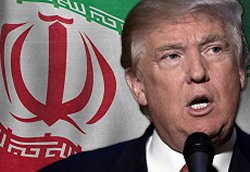
|
- Iran: Eight Prisoners Hanged on Drug Charges
- Daughter of late Iranian president jailed for ‘spreading lies’ - IRAN: Annual report on the death penalty 2016 - Taheri Facing the Death Penalty Again - Dedicated team seeking return of missing agent in Iran - Iran Arrests 2, Seizes Bibles During Catholic Crackdown
- Trump to welcome Netanyahu as Palestinians fear U.S. shift
- Details of Iran nuclear deal still secret as US-Tehran relations unravel - Will Trump's Next Iran Sanctions Target China's Banks? - Don’t ‘tear up’ the Iran deal. Let it fail on its own. - Iran Has Changed, But For The Worse - Iran nuclear deal ‘on life support,’ Priebus says
- Female Activist Criticizes Rouhani’s Failure to Protect Citizens
- Iran’s 1st female bodybuilder tells her story - Iranian lady becomes a Dollar Millionaire on Valentine’s Day - Two women arrested after being filmed riding motorbike in Iran - 43,000 Cases of Child Marriage in Iran - Woman Investigating Clinton Foundation Child Trafficking KILLED!
- Senior Senators, ex-US officials urge firm policy on Iran
- In backing Syria's Assad, Russia looks to outdo Iran - Six out of 10 People in France ‘Don’t Feel Safe Anywhere’ - The liberal narrative is in denial about Iran - Netanyahu urges Putin to block Iranian power corridor - Iran Poses ‘Greatest Long Term Threat’ To Mid-East Security |
Wednesday 13 July 2011Iran’s Nuclear Moves Point to Increased Tensions
The conflict over Iran’s nuclear program appears to be getting worse. In June, Iran decided to relocate 20 percent enrichment at its fortified Fordow enrichment plant near Qom and install advanced centrifuges that would triple its enrichment output. These steps will make it easier for Iran to quickly break out to nuclear weapons. As British Foreign Secretary William Hague pointed out in a recent Guardian op-ed, moving enrichment to Fordow and tripling output makes little sense in terms of its civilian nuclear program, which Iran claims is the only purpose of its nuclear program. Iran’s decision to move 20 percent enrichment to Fordow could be aimed at acclimatizing the international community to conditions that would make a breakout to nuclear weapons more feasible. By increasing the enrichment level and its stock of 20 percent low-enriched uranium, Iran could reach a so-called “break out” capability that would enable it to make enough weapon-grade uranium for a nuclear weapon in a few months. Iran already has the knowledge to build a crude nuclear weapon, according to the IAEA. In the absence of a negotiated settlement, Iran appears to be steadily moving to a status as a virtual nuclear weapons state in which it could build nuclear weapons quickly and easily. Once it reaches this capability, what will the Iranian regime decide? Will the temptation be too great to resist? In order to bridge the gulf and prevent Iran’s slow slide to nuclear weapons, the most viable option for the international community is an intensified dual track approach of both pressure and negotiations. Source: The Iran Primer |






